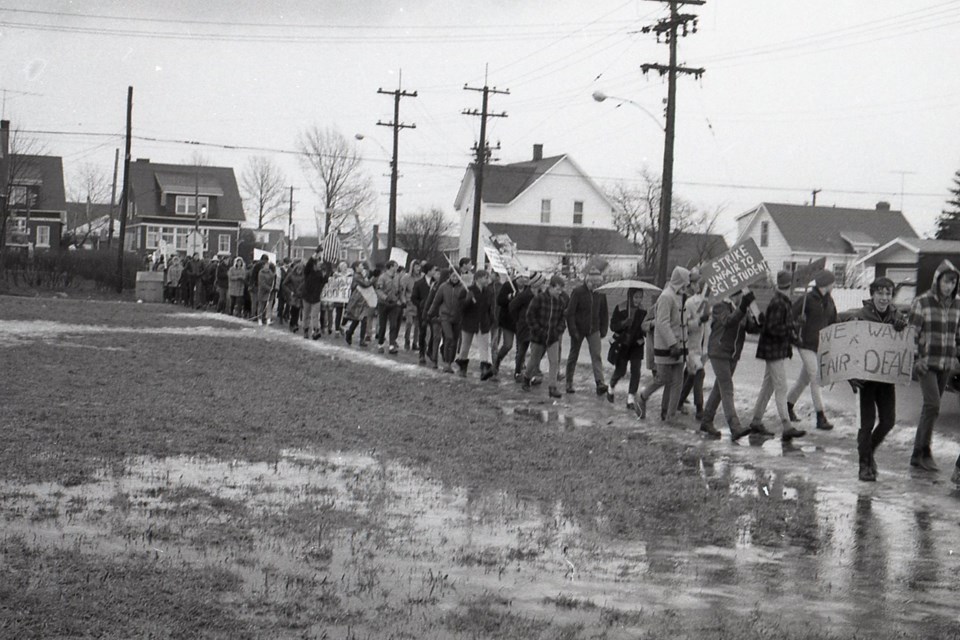From the archives of the Sault Ste. Marie Public Library:
Overcrowding is often a concern in schools. For high school students in 1968, that concern was taken to new levels because of labour action.
In July of 1968, Local 508 of the United Association of Plumbers and Steamfitters went on strike after contract negotiations fell apart. Their members had been performing construction work on several schools in the region, as well as a hospital in Blind River. All of these construction projects ground to a halt during the labour unrest. In some cases, these were projects that had already been slowed by a strike by the International Brotherhood of Electrical Workers, Local 1687, which had been in effect since May.
By the end of August, with no end in sight for the strike, the school boards released plans for how to accommodate students if their classrooms or schools were not ready by the first day of classes. Some classes – like at Rosedale – would be held in the auditorium. Other schools brought in portables.
Sault Collegiate in particular posed a problem: according to the Sault Star, a tour of the school revealed “many rooms without heating or lighting” and “a number of walls… yet to be finished.” Students would not be permitted back into the building at all. Instead, their entire student population of well over a thousand pupils would be absorbed by Sir James Dunn “on a staggered class basis.”
The staggered classes started in September. This wasn’t the Board of Education’s first go around with this method of combining schools: most recently, in 1967, 500 Korah students in grades 9 and 10 went to Bawating in shifts while their school was under construction.
On Friday, Sept. 5, at 7:30 a.m., classes began at Sir James Dunn for SJD students. Thanks to shortened class periods, their day ended at 12:30, and they had up to 20 minutes to clear school property before SCI students arrived on-site for their shift. In total, this involved coordinating the movements of approximately 2,400 students; off-duty police officers and safety officers were present to direct traffic and assist with the Anna McCrea and St. Marks students also in the area. The first day went off without a hitch, albeit with heavier traffic on surrounding streets.
As time wore on, the plumbers’ strike was beginning to wear on people. By November, frustrated with the lack of progress and with the plumbers being reassigned jobs out of town, a group of five wives picketed union offices, some wearing Halloween masks to conceal their identity. “I think they ought to stay home and wash their dishes,” said a union spokesman.
Similarly, while the actual implementation of the shift system may have worked smoothly for SJD and SCI students, it grew tiresome as time wore on. In a column titled “How much must we endure?” Sault Star columnist Jody Curran outlined some of the issues with the temporary school schedule: students having to be up by 5 a.m. or not returning home until as late as 8 p.m., suspended athletics, reduced prep time for teachers, and restructured classes. “[T]he disruption of the home lives of parents and students can never be repaired,” he wrote.
In November, the electrical workers ended their strike, and work could recommence on the school projects; plumbers were still out, and management personnel began working on some plumbing projects at Sault Collegiate in the interim, leading the plumbers to picket in front of the school. In December, rumours started to fly that Sault Collegiate would reopen in January and students would be back in their original classes, although education officials were unwilling to provide any formal statements.
On Dec. 13, a couple hundred frustrated SCI students gathered at the YMCA to hold a protest against the strike. They held signs critical of the plumbers and the strike – “plumbers are bummers,” “leadpipe the plumbers,” “Quit fighting children and let young adults go to school,” and “Is responsibility only for teenagers?”
Students also “hanged a striking plumber in effigy and [marched] to the ‘Collegiate’ carrying the symbolic plumber swinging from the scaffold.” They doused it with gasoline and attempted to burn the plumber and scaffold, but police quickly intervened and put out the fire. Students then surrounded the police car, with at least one student saying, “What do you say we turn the paddy wagon over?”
The situation de-escalated from there, and the protest ended peacefully. Students gathered up signs to provide to Sir James Dunn students, who would be hosting their own picket.
Finally, in January 1969, the news broke that Sault Collegiate would be opening once again. On Jan. 28, students were back in their intended schools. As for the plumbers, they ratified their new contract and officially ended the strike in March of 1970, almost two years since first walking out.
Each week, the Sault Ste. Marie Public Library and its Archives provide SooToday readers with a glimpse of the city’s past.
Find out more of what the Public Library has to offer at www.ssmpl.ca and look for more "Remember This?" columns here.
